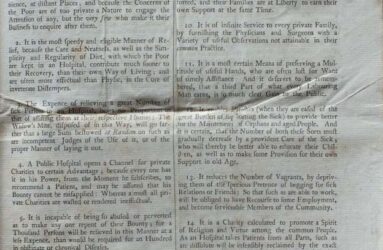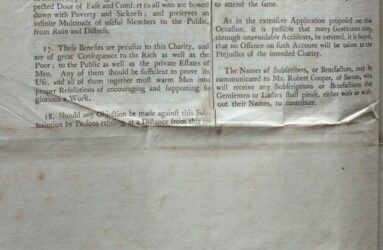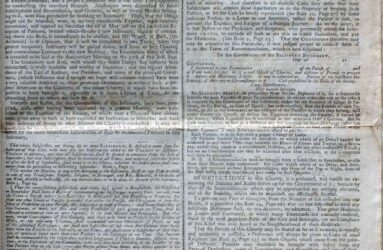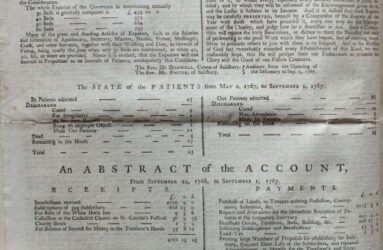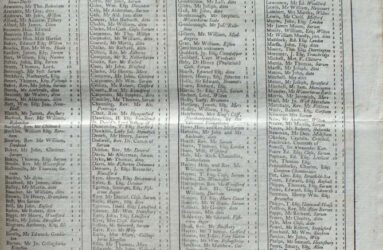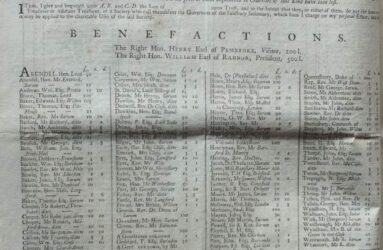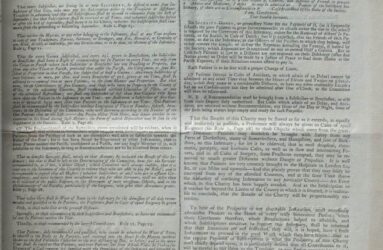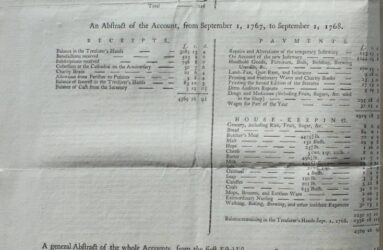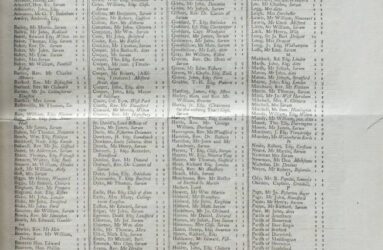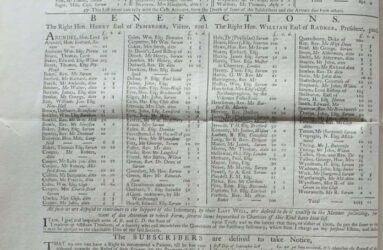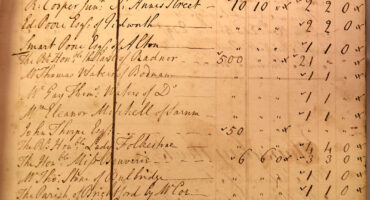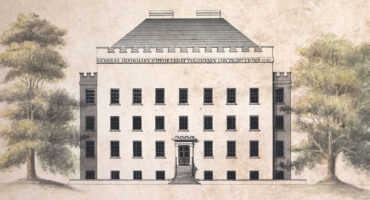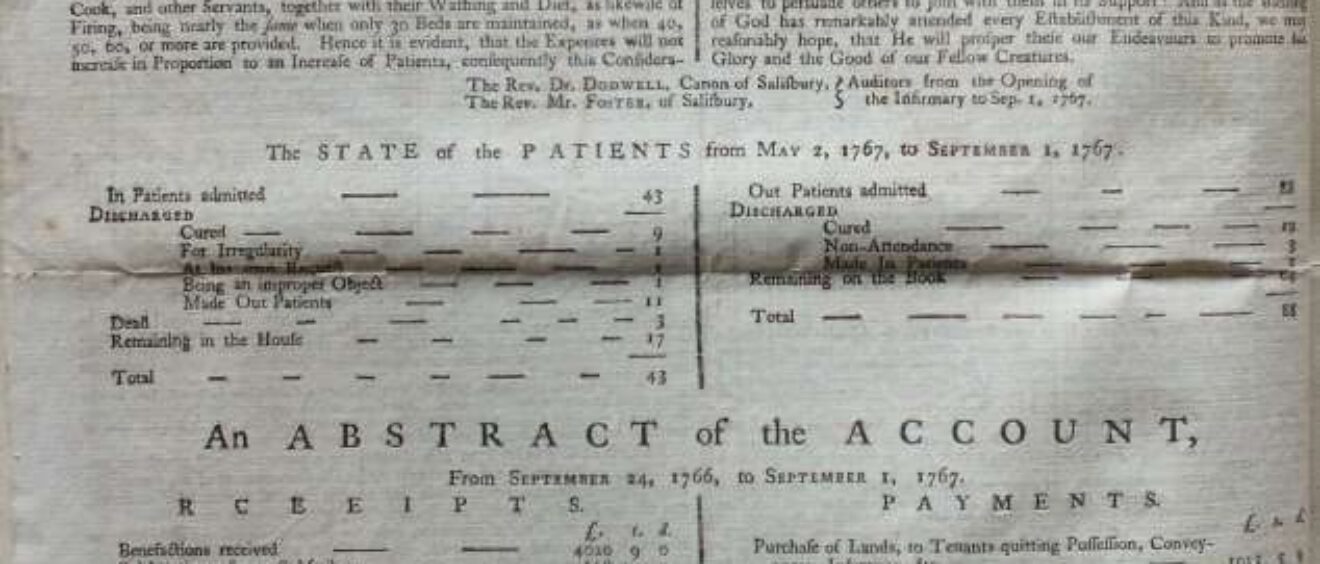
SGI 1767-1870: Governance
Research by Stuart Wakefield
The Governors of the Infirmary were selected from donors, who were either Subscribers making an annual donation or Benefactors providing monetary support either before their death or within their Last Will. Both in-patients and out-patients from any location were accepted, and rather than in-patients being recommended for admission by a doctor, they were sponsored by donors. At the outset, every Subscriber of one guinea [£135 *2022 values are shown within square brackets] and every Benefactor of £25 [£3,214] was entitled to recommend one needy person to be admitted to the Infirmary as an in-patient. In 1802, Subscribers had to pay two Guineas [£156] to gain this privilege.
Auditors were normally, appointed at the Annual Meeting of Governors from an alphabetical list of Subscribers, and they usually served for a twelve-month term. However, the posts were sometimes held for two consecutive years, and on a few occasions, a single Auditor was selected. The Auditors’ Report was presented shortly prior to the Annual Meeting of Governors and was structured to convey specific detail, although the content developed over time. Initially, the Reports included detail relating to the number of in-patients and out-patients over the twelve-month period along with the total figures since the Infirmary first accepted patients. Similarly, detail relating to receipts and payments upon selected items over the year were provided along with the totals since inception. Current Subscribers and Benefactors with their individual contributions were also included.
From 1827, the average number of in-patients throughout the year was added, and from 1850, a table summarising the receipt and expenditure of selected items for the last fourteen years was provided. From 1852, Reports were presented in an enhanced format which was stated to be “… more convenient for reference and preservation”. and at the same time the page size was reduced from approximately 21.5 x 12 inches to a standard 8 x 5 inches. In addition, a fixed date of 31 July was adopted for authorising the Reports. A list of officers and senior staff was added, as was the House Surgeon’s “Classification of Diseases” for the year which detailed the number of patients suffering from various medical conditions, plus casualties admitted and operations performed. In addition, comprehensive detail relating to receipts and payments was provided. From 1855, the Report was no longer authorised by the Auditors, but was signed by the Chairman of a Committee that approved the Report. From 1857, a table was added showing the length of time that in-patients were resident in the Infirmary, and from 1865, two further tables were added that showed the weekly average number of in-patients, plus the prices paid for selected supplies.
Over one hundred years from 1771, the number of annual Subscribers increased from 415 paying a total of £915 [£117,634] to 558 paying a total of £1,416 [£128,388]. Over the same period, the number of Benefactors increased from 176, contributing a total of £4,619 [£593,825] to 102 committed to donating a total of £11,845 [£1,085,407]. The Reports also detailed single donations, dividend payments, legacies and charity collections. The Report of 1870 detailed three classes of Benefactors who were Life Governors “By virtue of Benefactions”, Executors who were made Governors “In consequence of their having in character of Executors, paid Legacies”, plus those “Not being Governors, but entitled to recommend patients”.
1768 Annual Auditors’ Reports 1766 to 1851 (AR1) – To avoid abuse of the patient recommendation system, it was stated that “Every Subscriber is desired … not to give a recommendation for a patient to anyone who requests it, when he, who makes the request, is capable of subscribing himself”.
1768 AR1 – Auditors gently reminded Subscribers of their commitment by trusting that “… none will be offended, as every man is liable in the multiplicity of his avocations, to forget to pay his subscription regularly”.
1768 SWJ – 29 August; Almost straight away, the Governors stepped in and adopted a firmer stance by advising that “Subscribers in arrears are desired to pay them accordingly, otherwise the Auditors will be obliged to print their names in the Column of Arrears” Two weeks later, their position softened in a further published statement that “… such insertion might give offence in the infancy of the Infirmary … no such Column should appear in this Year’s Report …”. In fact, no such column ever appeared.
By 1800, all Subscribers of one Guinea [£67] per annum, and Benefactors of at least that sum, were requested to attend the Anniversary Meeting. In addition, every annual Subscriber of two Guineas [£134] automatically became a Governor.
1801 AR1 – The Governors regularly sought to increase donations to the Infirmary, and a resolution was passed stating that “Executors are not to be elected Governors for Life unless the legacies which they pay respectively produce £50 [£2,852] or upwards …”.
1821 Salisbury and Winchester Journal (SWJ) – 5 November; The Governors sought to impose more rigorous procedures and published a Notice that “The following rules of the Radcliffe Infirmary in Oxford, will probably be adopted at the next Quarterly Court of the Salisbury Infirmary:
- A letter is to be sent by the secretary to every subscriber who shall be four years in arrears and upwards, to beg the favour of knowing whether the name is to be continued.
- Every Parish, after being two years in arrears, and having been apprized by the secretary of the consequence of continuing in arrear, shall be struck off the list, and not allowed to subscribe again, until the said two years’ arrears shall have been discharged.
- No recommendation shall be taken from any Parish unless they have subscribed one month before the time of such recommendation.
- Every Parish officer recommending a patient to this Infirmary, will in future be required to deposit one Guinea [£88] with the secretary, for defraying the expenses of his or her removal, in case such officer shall be guilty of neglect after receiving due notice of the discharge of his patients; which Guinea will, nevertheless, be repaid to such Parish officer as shall in due time remove the patients he recommended”.
1827 AR1 – The requirement for those elected Governors for Life was increased to provide legacies “… which they pay respectively to produce £100 [£8,050] or upwards …”.
1827 AR1 – Auditors encouraged greater participation in the affairs of the charity by stating “As all Subscribers of two guineas [£169] a year have a right to act at every Committee and every Court, and to enquire into all affairs of the Society, they are hereby desired to make frequent use of this power and are assured that their presence for this purpose is considered as a valuable addition to their charity”.
1828 AR1 – Auditors noted with the deepest regret “… several losses the Infirmary has sustained. At the commencement of the year, it was deprived by the death of the Visitor, the late Earl of Pembroke and Montgomery, who by his liberal benefactions during his life and the munificent legacy at his decease, manifested his attachment to this Institution. The Marquis of Ailesbury has been unanimously elected his successor.
This vacancy had, however, been scarcely supplied ere the Governors had to deplore the death of their President, the late Earl of Radnor, a loss the extent of which cannot be more adequately expressed than in the Resolution of the Special Court on the occasion, viz: That this Board deeply deplores the loss which this Institution has sustained by the death of one of its most distinguished Members, the late Earl of Radnor, who, from his first entrance on public business to the latest period at which his health permitted him to attend it, made this Infirmary the object of his paternal care and most liberal patronage. At the same court, the present Earl of Radnor was unanimously elected President in the room of his late Father, an election which cannot fail to meet with the approbation of every friend of the Institution”.
1844 Proposed Alterations in the Statutes, filed within AR1 – Compulsory retirement was mooted by the proposal “That no Physician or Surgeon shall be re-elected who has attained the age of 65 years; but this Statute shall not in any way apply to the present Physicians or Surgeons”.
In addition, it was proposed that :
- “The Physicians and Surgeons during attendance shall be Governors and shall have the privilege of recommending two in-patients and four out-patients in addition to their right as Subscribers if they should be such.
- … any Physician or Surgeon, who has served the Institution for a period of 21 years, shall, upon his retirement, be elected to the Office of Consulting Physician or Surgeon.
- The House Surgeon shall not absent himself during the day upon which an operation shall have been performed without permission of the Surgeon.
- With a view to the discharge of over-time in-patients, all the Medical Officers … shall on the first Wednesday in every month … hold a consultation on the cases … of all the patients who shall have been in the hospital eight weeks or upwards, to decide upon the priority of their being retained longer, reference being had in each case to the probability of a cure, or a very considerable benefit if the patient be allowed to remain a further reasonable time … any permission to remain shall not extend beyond one month, at the end of which time a consultation shall again be held …”.
1861 Annual Auditors’ Reports 1852 to 1861 (AR2) – The Annual Court directed that a petition be presented to Her Majesty for Her Royal Charter of Incorporation.
1862 SWJ – 25 October; A Notice advised that “… a Special Court of Governors will be held … for the purpose of receiving the Charter of Incorporation granted by the Crown to the Governors of this Infirmary, to enact bye-laws comprising such portions of the statutes as are not included in the new Charter, to order the transfer of all monies in the funds, and the conveyance of the lands and buildings belonging to the Infirmary into the name of the Corporation, to approve of a corporate seal and a special bye-law in regards thereto, and authorise the seal to be affixed to any deeds or letters of attorney that may be necessary by reason of the real and personal property being vested in the new Corporation, and generally to do all or any act or acts in consequence of the said Charter, or incidental thereto, which the Governors attending the Special Court may consider necessary or expedient …”.
1863 AR3 – The Auditors reported a balance due to the Treasurer of £499 19s 9d [£47,853] which had been “… chiefly occasioned by the cost of procuring the Charter of Incorporation” and they anticipated the benefit as “… The rendering our Institution a corporate body, which has thus been legally effected will, it is believed, promote the interests of the Infirmary in several important respects”.
1866 J8/112/1 Wiltshire & Swindon History Centre – “The Salisbury Infirmary Charter of Incorporation was signed … on 5 September in the twenty ninth year of Queen Victoria’s reign, and granted the following rights :
- the power to sue
- to have and use a common seal
- to purchase land up to an annual value of £2,500 [£212,238]
- to have a structure that exercised power, to convene meetings that made decisions, to have rules for ballots, (proxy voting was not permitted)”

